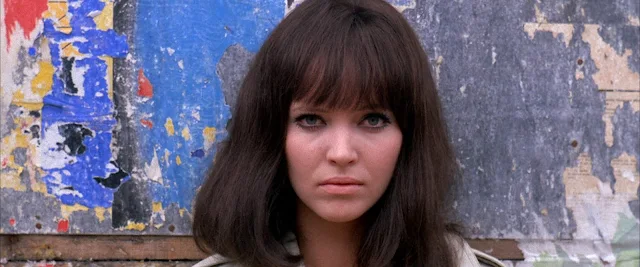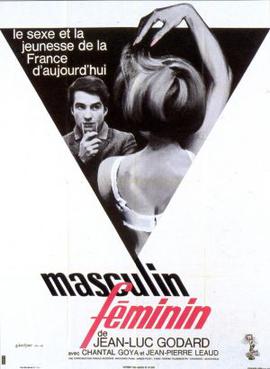 |
| Jean-Pierre Léaud in The 400 Blows |
Antoine Doinel: Jean-Pierre Léaud
Julien Doinel: Albert Rémy
Gilberte Doinel: Claire Maurier
René Bigey: Patrick Auffay
M. Bigey: Georges Flamant
Director: François Truffaut
Screenplay: François Truffaut, Marcel Moussy
Cinematography: Henri Decaë
Music: Jean Constantin
One of the unquestioned great movies, and one of the greatest feature-film directing debuts,
The 400 Blows would still resonate with film-lovers even if François Truffaut hadn't gone on to create four sequels tracking the life and loves of his protagonist, Antoine Doinel (Jean-Pierre Léaud). There are, in fact, those who think that the last we should have seen of Antoine was the haunting freeze-frame at the end of the film. But Antoine continued to grow up on screen, and perhaps more remarkably, so did Léaud, carving out his own career after his debut as a 13-year-old. (It's hard to think of any American child actors who were able to maintain a film career into adulthood as well as Léaud did. Mickey Rooney? Dean Stockwell? Who else?) Having Truffaut as a mentor certainly helped, but Léaud had an unmistakable gift. He is on screen for virtually all of the 99-minute run time, and provides a gallery of memorable moments: Antoine in the amusement-park centrifuge, Antoine in the police lockup, Antoine on the run -- in cinematographer Henri Decaë's brilliant long tracking shot. And my personal favorite moment: when the psychologist asks Antoine if he's ever had sex. Léaud responds with a beautiful mixture of surprise, amusement, and embarrassment. It's so genuine a response that I have to think it was improvised, that Truffaut surprised Léaud with the question. But even so, Léaud never drops character in his response. This praise of Léaud is not to undervalue the magnificent supporting cast, or the haunting score by Jean Constantin. It's a film in which everything works.
Antoine and Colette (François Truffaut, 1962)
 |
| Jean-Pierre Léaud and Marie-France Pisier in Antoine and Colette |
Antoine Doinel: Jean-Pierre Léaud
Colette: Marie-France Pisier
Colette's Mother: Rosy Varte
Colette's Stepfather: François Darbon
René: Patrick Auffay
Albert Tazzi: Jean-François Adam
Director: François Truffaut
Screenplay: François Truffaut
Cinematography: Raul Coutard
Music: Georges Delerue
Four years after he made
The 400 Blows, Truffaut was asked to contribute to an anthology of short films by directors from various countries to be called
Love at Twenty. As he had with the first film, Truffaut drew on his own experience, an infatuation with a girl he had met at the Cinémathèque Française. And since Léaud was available -- he had worked with Julien Duvivier on
Boulevard (1960) after completing
The 400 Blows -- it made sense for him to play Antoine Doinel again. A narrator tells us that Antoine had been sent to another reform school after escaping from the first, and that this time he had responded well to a psychologist: After leaving school, he has found a job working for the Phillips record company and is living on his own. Then he sees a pretty young woman at a concert of music by Berlioz and falls for her. Colette is not much interested in him, but she is evidently flattered by his advances. Her parents like Antoine and encourage him so much that he rents a room across the street from them. (Truffaut had done the same thing during his crush.) But one evening when he comes to dinner at their apartment, a man named Albert calls on Colette and she leaves Antoine watching TV with her parents. It's a droll little film, scarcely more than an anecdote, and the stable, lovestruck Antoine doesn't seem much like either the rebellious Antoine of the first film or the more scattered Antoine of the later ones in the cycle.
Stolen Kisses (François Truffaut, 1968)
 |
| Jean-Pierre Léaud in Stolen Kisses |
Antoine Doinel: Jean-Pierre Léaud
Christine Darbon: Claude Jade
Georges Tabard: Michael Lonsdale
Fabienne Tabard: Delphine Seyrig
M. Blady: Michael Lonsdale
Mme. Darbon: Claire Duhamel
Lucien Darbon: Daniel Ceccaldi
Director: François Truffaut
Screenplay: François Truffaut, Claude de Givray, Bernard Revon
Cinematography: Denys Clerval
Music: Antoine Duhamel
The Antoine of
Stolen Kisses is in his 20s, but
has reverted to the more haphazard ways of his adolescence: He has been kicked out of the army, and now relies on a series of odd jobs to get by. But he has also renewed acquaintance with a young woman he met before going into the army, Christine Darbon. Like Colette's parents, hers are quite taken with Antoine, and they help him get a job as a night clerk in a hotel. He gets fired from that job after helping a private detective who is spying on an adulterous couple, but the detective helps Antoine get a job with his agency. While working for the detective agency, he has to pose as a clerk in a shoe store, and winds up in a liaison with the store owner's wife, Fabienne. When that ends badly, he becomes a TV repairman, which brings him back to Christine, with whom he winds up in bed after trying to fix her TV. At the film's end, a strange man who has been following Christine comes up to her and Antoine in the park and declares his love for her. She says he must be crazy, and Antoine, who perhaps recognizes his earlier infatuation with Colette in the man's obsession, murmurs, "He must be."
Stolen Kisses is the loosest, funniest entry in the cycle, though it was made at a time when Truffaut was politically preoccupied: The film opens with a shot of the shuttered gates of the Cinémathèque Française, which was shut down in a conflict between its director, Henri Langlois, and culture minister André Malraux. This caused an uproar involving many of the directors of the French New Wave. Some of Antoine's anarchic approach to life may have been inspired by the rebelliousness toward the establishment prevalent in the film community. But it's clear that the idea of a cycle of Antoine Doinel films has been brewing in Truffaut's mind: There is a cameo appearance by Marie-France Pisier as Colette and Jean-François Adam as Albert, now married and the parents of an infant.
Bed and Board (François Truffaut, 1970)
 |
| Claude Jade and Jean-Pierre Léaud in Bed and Board |
Antoine Doinel: Jean-Pierre Léaud
Christine Darbon Doinel: Claude Jade
Mme. Darbon: Claire Duhamel
Lucien Darbon: Daniel Ceccaldi
Kyoko: Hiroko Berghauer
Director: François Truffaut
Screenplay: François Truffaut, Claude de Givray, Bernard Revon
Cinematography: Néstor Almendros
Music: Antoine Duhamel
Antoine and Christine have married, and they have settled down in a small apartment. (There's some indication that it's paid for by her parents.) She gives violin lessons and he sells flowers -- carnations, which he dyes, using some environmentally questionable potions. But settling down isn't in Antoine's nature, and when Christine gets pregnant he looks for more lucrative work. He finds a curious sinecure in a company run by an American: Antoine maneuvers model ships by remote control through a mockup of a harbor. ("It gives me time to think," he says.) One day, a Japanese businessman comes to see the demonstration, accompanied by a pretty translator named Kyoko (Hiroko Berghauer), and Antoine is soon involved in an affair with her. Naturally, this precipitates a breakup, though by film's end they have seemingly reconciled. Still, it's obvious that the marriage is not destined to be permanent. They can't even agree on a name for their son: She wants him to be called Ghislain, and he wants to call him Alphonse. Antoine wins out by a trick: He's the one who goes to the registry office to legalize the boy's name. Antoine also spends time writing a novel about his boyhood, to which Christine objects: "I don't like this business of writing about your childhood, dragging your parents through the mud. I don't know much but I do know one thing: If you use art to settle accounts, it's no longer art." Truffaut had his own regrets about the portrait of his parents in
The 400 Blows. Less farcical than
Stolen Kisses,
Bed and Board still has a strong vein of comedy tinged with melancholy.
Love on the Run (François Truffaut, 1979)
 |
| Claude Jade and Jean-Pierre Léaud in Love on the Run |
Antoine Doinel: Jean-Pierre Léaud
Colette Tazzi: Marie-France Pisier
Christine Doinel: Claude Jade
Liliane: Dani
Sabine Barnerias: Dorothée
Xavier Barnerias: Daniel Mesguich
M. Lucien: Julien Bertheau
Director: François Truffaut
Screenplay: François Truffaut, Marie-France Pisier, Jean Aurel, Suzanne Schiffman
Cinematography: Néstor Almendros
Music: Georges Delerue
Truffaut admitted that he wasn't happy with the final film in the cycle. It's a bit too heavily reliant on flashback clips from the four earlier films, and if it's intended to show that Antoine has finally stabilized now that he's in his 30s and divorced from Christine, it doesn't quite make the case. He has a new girlfriend, Sabine, his novel has been published several years earlier, and he works as a proofreader for a printing house. He's on friendly terms with Christine, and agrees to take their son, Alphonse, to the train station when the boy leaves for a summer music camp. At the station, he runs into Colette, now a defense lawyer, who is on her way to confer with a client -- a man who has murdered his 3-year-old boy. Perhaps a little too coincidentally, Colette is involved with Sabine's brother, Xavier, and having encountered Antoine before, she has bought a copy of his novel to read on the train. Antoine impulsively boards the train, and sets up a meeting with Colette in the dining car, after which she invites him back to her compartment. All of this sets up a series of revelations: Colette's marriage to Albert broke up after their small daughter was killed by a car. She claims that she supplements her small income as a lawyer by prostituting herself with men she meets on trains. Antoine finally made peace with his mother after her death when he met her old lover, M. Lucien, who persuaded him to visit his mother's grave. (There is a flashback to the scene in
The 400 Blows when Antoine, playing hooky, sees his mother kissing a strange man on the street.) Antoine became infatuated with Sabine after hearing a man in a phone booth arguing with a woman on the other end of the line and then tearing up her photograph. Antoine picked up the pieces from the floor, put them together, and after some sleuthing, discovered the woman was Sabine. His marriage to Christine finally broke up after he slept with her friend Liliane, who he previously had thought was having a lesbian relationship with Christine. And so on. The result of all the flashbacks and revelations is not to round out the Antoine Doinel saga, but to make
Love on the Run feel over-contrived. Marie-France Pisier, incidentally, contributed to the screenplay, which is mostly by Truffaut.














































.jpg)

